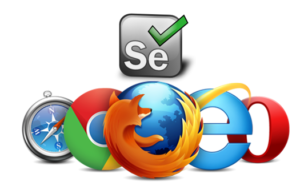Selenium – Everything you need to know about it!
Selenium is a portable framework for testing web applications. Selenium provides a playback (formerly also recording) tool for authoring functional tests without the need to learn a test scripting language. It is a portable framework for testing web applications which Are open-source software. Primarily used for automating web applications for testing purposes but is certainly not limited to just that, it also provides a test domain-specific language (Selenese) to write tests in a number of popular programming languages including C#, Groovy, Java, Perl, PHP, Python, Ruby, and Scala. Selenium deploys on Windows, Linux, and macOS platforms.
Selenium is composed of several components with each taking on a specific role in aiding the development of web application test automation:

-
Selenium IDE:
Selenium IDE is a complete integrated development environment (IDE) for Selenium tests. It and allows recording, editing, and debugging of functional tests. Scripts may be automatically recorded and edited manually providing auto completion support and the ability to move commands around quickly. Scripts are recorded in Selenese, a special test scripting language for Selenium.
-
Selenium client API:
As an alternative to writing tests in Selenese, tests can also be written in various programming languages. These tests then communicate with Selenium by calling methods in the Selenium Client API.
-
Selenium WebDriver:
Selenium WebDriver is the successor to Selenium RC. This is implemented through a browser-specific browser driver, which sends commands to a browser and retrieves results.
-
Selenium Remote Control:
Selenium Remote Control (RC) is a server, written in Java that accepts commands for the browser via HTTP. RC makes it possible to write automated tests for a web application in any programming language.
-
Selenium Grid:
Selenium Grid is a server that allows tests to use web browser instances running on remote machines. With Selenium Grid, one server acts as the hub. Tests contact the hub to obtain access to browser instances.
The benefits and uses of Selenium test automation hold relevance across diverse business segments…
-
1. Open-Source:
The biggest strength of Selenium is that it is a freeware and a portable tool. It has no upfront direct costs involved.
-
2. Supports languages:
Selenium supports a range of languages, including Java, Perl, Python, C#, Ruby, Groovy, Java Script, etc. It has its own script, but it doesn’t limit it to that language.
-
3. Supports Operating Systems:
Selenium can operate and support across multiple Operating Systems (OS) like Windows, Mac, Linux, UNIX, etc. With Selenium Suite of solutions, a tailored testing suite can be created over any platform and then executed on another one.
-
4. Support across browsers:
Selenium provides support across multiple browsers, namely, Internet Explorer, Chrome, Firefox, Opera, Safari, etc. This becomes highly resourceful while executing tests and testing it across various browsers simultaneously.
-
5. Support for programming language and framework
Selenium integrates with programming languages and various frameworks. For example, it can integrate with ANT or Maven type of framework for source code compilation
-
6. Tests across devices
Selenium Test Automation can be implemented for Mobile web application automation on Android, IPhone, and Blackberry.
-
7. Ease of implementation
Selenium offers a user-friendly interface that helps create and execute tests easily and effectively. Its Open-Source features help users to script their own extensions that make them easy to develop customized actions.








